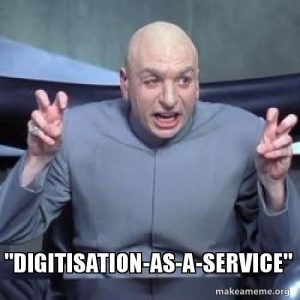(This was an extract following the publishing of my book in 2014 – “Rest In print” and subsequent blog post)
How will the Manage Print Services Industry evolve?
Watch out Managed Print Services (MPS), here comes Digitisation-as-a-Service (DaaS).
I know, I know. Is there such a thing as DaaS? Are we reusing or spinning an old story to create a new one? What about Printing-as-a-Service (PaaS). Isn’t this more related to MPS? Or is Printing-as-a-Service still too heavily focused on the physical world of print output and page counts?
Also, don’t we have ample “as-a-service” models now?
Yes, for many people out there we do. But most are very appropriate as they can deliver a better service outcome for customers that are both cost effective and resource efficient.
Everything-as-a-Service:
There are many well known as-a-service models such as, Infrastructure-as-a-Service (IaaS), Software-as-a-Service (SaaS), Platform-as-a-Service (PaaS), Desktop-as-a-Service (DaaS) and the list goes on.
Some of the questions that may need to be asked prior to venturing down this freeway are; is there an explicit customer requirement today for hardcopy documents to be digitised? Which providers can manage the process of digitising content, Is this an on premises or a remote (off location) process? How will the provider, provide this service via a cloud based service provision or something else?
More importantly how will the provider add value to the customer in the process.
Or are these just services-orientated marketing fads and talk tracks or is there more to this than we realise for the office printing industry?

Yes – it could be more of the same. Just another evolution or merger of Managed Print Services, Content Managed Services, Document Management, Workflow and Process Optimisation and Business Process Services (BPO) all bundled together?
What you should be asking yourself?
Too understand this more. Ask yourself this question. How evolved is your Managed Print Service Provider today? How are they positioning themselves in a world that is printing less than it used too?
Has their behaviour changed in how they consult, manage, support and transact with clients? How well are they demonstrating the transition from a paper centric world to a more digitally enabled economy? Are they helping grow their client’s business or just reducing the cost structures that support today’s generic print activities?
In response to these questions. We know if we talk to some providers they are certainly changing and evolving their capabilities, direction and their agility to respond.
Why are they doing this?
Well it’s simple really, they are listening to the customer and adapting.
They no longer see the office printing segment as the nirvana it once was. They are addressing the needs of the client, not hiding from them.
This is the key difference.

Unfortunately, however, the flip side to this is that some print providers around the world including Australia and New Zealand still see print (specifically the hardware devices and print output volumes) as their last bastion. They remain focused on squeezing everything thing out of it as they can.
Maybe for some it’s more of an obsession or it’s about the last one standing will win.
Ultimately, “this legacy will become their legacy”. But everyone has a choice, right?
So does Digitalisation-as-a-Service make sense? Who would want this?
Is DaaS the next evolution of Managed Print Services or is DaaS a component or segment of MPS? Or are they unrelated?
So how real is Digitisation-as-a-Service?
Well let’s ask the question.
Do customers want to have a service provider come to them and say; hey, how about we help you migrate and manage all your hardcopy physical documents into a digital format?
So you can provide a better customer experience and at the same time your team will be more efficient and productive.
You know those documents that are coming into your business circulating through your business or sitting there as frozen intellectual property (IP), doing nothing.
All that IP and content trapped in time and locked up in endless warehouses, filing compactors, boxes and filing cabinets and turn them into a digital and reusable format.
Wow, maybe we can even help you commercialise the content through a digital based app and drive new revenue streams for your business.
Maybe some of that content is an asset after all.
Imagine how the client’s customer would feel?
They don’t always have to fill out paper based forms, wait days, weeks or months for something to be processed only to find out the form or paperwork has gone missing. Or they have completed the wrong form to start with. How good would it be if the end consumer/client didn’t have to supply the same information over and over again to different departments within the same firm?
If this was such a good idea, we would have done this already. Wouldn’t we?
So why change, really?

The speed of a Digital Society:
Hey, we know the world is accelerating at pace, the future is a lot closer than we think and today your business as well as your customer’s business must be operating effectively in a digital economy just as much as its operating in any physical sense. That is, if you are still a bricks and mortar business.
So let’s speed up their business.
Paper and more importantly paper-based processes may be slowing a business down to a point that their competitors now are acquiring customers and engaging with customers much faster than they can.
Don’t forget your customers are dealing with the paper-trail and this may be hurting them.
So why are some traditional competitors now outperforming and out-competing your customer? How are new entrants competing against them so effectively?
There is a new breed of competition as a result they may not be able to defend against them as easily as they had in the past.
The playing field has changed and so have the rules.
A Digital Native:
Their competitors have become more agile businesses and now have a competitive advantage. Some are born in a digital world. Others have had to refocus and re-innovate their businesses so they can better engage and operate digitally. Look at banking as an industry that is currently transforming to connect and transact on digital based platforms specifically mobile based solutions.
They are trying to transition as they see the green field Neo-banks of the future cutting into their customer base.
To be successful in this transition to a digital economy, businesses must change the way they operate, function and leverage resources within and across their business. They have to adapt to a new economy that is customer led and focused.
Many organisations who go through this process have identified that paper and specifically the paper processes make people less efficient which ultimately costs the business money.

These businesses recognise that they have to by-pass paper and many of the labour intensive and costly tasks that once supported a paper based process.
New providers who are focused around digitisation-as-a-service understand their role is not only digitising hardcopy content But also working with clients to manage content in its many forms.
More and more you will see providers work in areas of digital enablement where content is repurposed, shared and processed across digital platforms such as mobile based app’s.
The future of Managed Print Services (MPS)?
This stage of evolution is potentially where managed print services and document imaging companies are heading. They are integrating their capabilities, skills, experience and core competencies from print output to digitisation services.
More importantly they are focusing on working with the business to help change the way the business communicates and interacts not only with its customers, but its employees as well.
Most of these providers are using technology as the enabling piece wrapped up within a service led provision that is outcome based. Not brand, not device, not manufacturer led.
The first step in this journey is to identify what is essential office printing and what is not. We state this as many customers still require a physical print output requirement.
However, at the same time providers should be working to identify where areas of business and staff productivity can be improved and costs can be taken out.
The secret however is how you can add to your customer top line revenue growth – now this changes the proposition totally doesn’t it.
The As Is to a To Be
Most providers who have competence in assisting the client to move from an “As Is” to a “To Be” state, would have a sound and robust methodology to manage this engagement. This is really about reducing risk for the client.
With this in mind, we would expect new age and leading services providers to clearly map some of the preliminary but critical aspects and paths required in the process of digitisation.
This would include auditing and weighting content value, assessing documents life-cycle, measuring and analysing the workflow processes that occurs in supporting communications both internally and externally and this includes understanding existing digital workflows etc.
Although each industry and to some extent each business has its nuances, much of the paper related processes that exist today are becoming more and more redundant and therefore becoming much easier to identify and extract for businesses in general.

With this said, what type of service provider are you becoming and how are you aligning to your customer’s new business requirements and needs?


